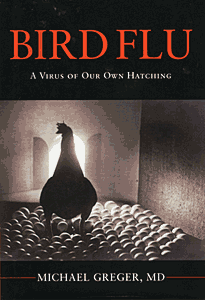Book Review
Bird Flu: A Virus of Our Own Hatching
by Michael Greger, MD
Lantern Books, 2006
Review by Karen Davis, PhD, President of United Poultry Concerns
“As long as there is poultry, there will be pandemics.” Bird Flu, p. 346

Bird Flu, by Dr. Michael Greger, of The Humane Society of the United States, provides a comprehensive look at the conditions responsible for the spread and mutations of highly pathogenic avian influenza. His detailed account is summarized by Professor Emeritus Kennedy Shortridge, a molecular biologist at the University of Hong Kong who is credited with having first discovered the deadly H5N1 virus in Asia. Shortridge writes in the Forward:
It is the siting of large-scale chicken production units, particularly in southern China where avian influenza viruses abound, that is the crux of the problem. There, domestic ducks have been raised on rivers, waterways, and, more recently, with the flooded rice crops cultivated each year. The importation of industrial poultry farming into that same region introduced millions of chickens – highly stressed due to intensive production practices and unsanitary conditions – into this avian influenza milieu. The result? An influenza accident waiting to happen. The H5N1 virus signaled its appearance in Hong Kong in 1997, and has since made its way into dozens of countries, infected millions of birds, and threatens to trigger a human catastrophe.
Greger’s story of bird flu is about how human activities and attitudes are generating filth, sickness, and bizarre biological reactions, perhaps to an unprecedented degree, from the gene to the global scene. Whatever may happen to humans as a result of our mischief, for the birds the catastrophe has arrived. Evidence suggests that the chicken is not a natural host for influenza. Reading this, I’m reminded of how Salmonella enteritidis, a strain of intestinal bacteria that can pass from chickens to consumers and handlers of poultry and egg products, migrated in battery-caged hens in the 20th century from their intestines to their ovaries to become part of the very formation of their eggs. Our horrible treatment of chickens shows a malaise in people of which bird flu is a manifestation. I’d call it an epiphany of evil if grand phrases didn’t cheapen the facts.
Greger rightfully indicts factory farming, cockfighting, and live bird markets and shows how these trades are interconnected at local, regional, national and transnational levels. He shows how governments protect these trades while talking trash about protecting public health. He shows how the poultry industry conceals sick birds so people won’t know they’re “buying infected meat and eggs” (p. 350). He describes the “Tysonization” of Thailand and the rest of Asia, where traditional farming practices (without any help from Tyson, of which Asia has its own versions) include this technique:
Pig-hen-fish aquaculture involves perching battery cages of chickens directly over feeding troughs in pig pens which in turn are positioned above fish ponds. The pigs eat the bird droppings and then defecate into the ponds. Depending on the species of fish, the pig excrement is then eaten directly by the fish or acts as fertilizer for aquatic plant fish food. (pp. 138-139)
This method of feeding excrement to farmed animals is a metaphor for how farmed animals around the world really are fed and how much of the world’s plant agriculture is fertilized. Farmed animals are fed each others’ infected body parts and manure. Farmed animal feed is a dumping ground for farmed animal “waste.” Egg-laying hens are fed “spent hen meal.” In a report last year on the poultry industry’s leading role in promoting bird flu, the agribusiness watchdog group GRAIN noted that a standard ingredient in industrial chicken feed and most industrial animal feed is poultry litter, “a euphemism for whatever is found on the floor of the factory farms: fecal matter, feathers, bedding, etc.” (“Fowl play,” Feb. 2006, p. 13)
While Bird Flu is replete with information, expert opinions, dire predictions, and pages on how to protect oneself from the flu or lessen its effect, it does not go the distance. Declarations like “extreme remedies are most appropriate for extreme diseases” (Hippocrates) and “The single biggest threat to man’s continued dominance on the planet is a virus” (Joshua Lederberg, Nobel laureate) do not lead clearly to a vegetarian solution or even a chicken-free solution. Top-heavy with the problem, the proposed remedy totters beneath.
A nod is given to the fact that people can live well, even better, without animal products by eating wholesome vegan food, but this “extreme remedy appropriate” for extreme diseases, is barely on the table (p. 344). Bird Flu assumes most people will eat animals even if it kills them and their families and spawns a pandemic. The more “practical” remedy is somehow to get rid of or scale back “factory farming,” so that an increasingly urban global population can continue to eat birds and other animals made dead, as it were, in little garden plots sprinkled around the earth.
If a vegetarian solution seems “unrealistic,” a significant shift away from industrial animal production practices to supply billions of omnivores seems even less likely. Here and there in the book, experts are quoted to the effect that increased consumption and demand for animal products around the world has led to factory-farming. But Bird Flu skirts the implications. I complained about it when asked to review the manuscript last summer. And for the record, chickens bred for the egg industry are not “scrawny,” as depicted on page 197. These birds have lithe, handsome, well-proportioned bodies – unless they’re being abused, of course. I pointed this out, but there it is in the book, alas. – Review by Karen Davis, PhD